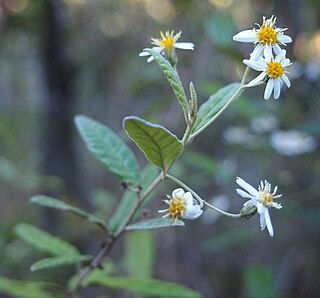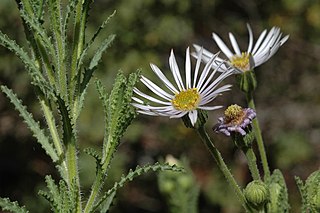
Olearia pimeleoides, commonly known as pimelea daisy-bush, is a species of flowering plant in the family Asteraceae and is endemic to southern continental Australia. It is an erect shrub with elliptic, linear or lance-shaped leaves, and white and pale yellow, daisy-like inflorescences.

Olearia megalophylla, commonly known as large-leaf daisy bush, is a species of flowering plant in the family Asteraceae and is endemic to south-eastern continental Australia. It is a spreading shrub with egg-shaped to elliptic leaves and white and yellow, daisy-like inflorescences.

Olearia astroloba, commonly known as marble daisy-bush, is a species of flowering plant in the family Asteraceae and is endemic to a restricted area of Victoria in Australia. It is a greyish shrub with sessile, spatula-shaped leaves and mauve or violet and purple, daisy-like inflorescences.

Olearia canescens is a species of flowering plant in the family Asteraceae and is endemic to eastern Australia. It is a shrub with scattered elliptic or egg-shaped leaves, and white and yellow, daisy-like inflorescences.

Olearia paucidentata, the autumn scrub daisy, is a species of flowering plant in the family Asteraceae and is endemic to the south-west of Western Australia. It is a shrub with variably-shaped leaves, and white, mauve or blue and mauve or yellow, daisy-like inflorescences.
Olearia arckaringensis, commonly known as Arckaringensis daisy, is a species of flowering plant in the family Asteraceae and is endemic to a restricted area of northern South Australia. It is a small, compact, rounded shrub with woolly-hairy foliage, coarsely-toothed, elliptic leaves and lavender or white and yellow, daisy-like inflorescences.
Olearia burgessii is a species of flowering plant in the family Asteraceae and is endemic to south-eastern New South Wales. It is a shrub with scattered elliptic to egg-shaped leaves with the narrower end towards the base, and white and yellow, daisy-like inflorescences.
Olearia elaeophila is a species of flowering plant in the family Asteraceae and is endemic to the south-west of Western Australia. It is a small shrub with scattered linear leaves, and white or blue and yellow, daisy-like inflorescences.
Olearia eremaea is a species of flowering plant in the family Asteraceae and is endemic to inland areas of Western Australia. It is a shrub with scattered, more or less elliptic leaves, and white and yellow, daisy-like inflorescences.
Olearia fluvialis is a species of flowering plant in the family Asteraceae and is endemic to inland areas of northern Western Australia. It is a shrub with scattered, narrowly egg-shaped leaves, and white or mauve and yellow, daisy-like inflorescences.
Olearia gordonii is a species of flowering plant in the family Asteraceae and is endemic to inland southern Queensland. It is a small, erect, spreading shrub with linear leaves and blue, daisy-like inflorescences.
Olearia incondita is a species of flowering plant in the family Asteraceae and is endemic to the south-west of Western Australia. It is a straggly shrub with narrowly elliptic leaves and white or pink and yellow, daisy-like inflorescences.

Olearia laciniifolia is a species of flowering plant in the family Asteraceae and is endemic to inland areas of the south-west of Western Australia. It is an erect shrub with scattered oblong leaves with small lobes on the edges, and lilac, white and yellow, daisy-like inflorescences.
Olearia lasiophylla is a species of flowering plant in the family Asteraceae and is endemic to south-eastern New South Wales. It is a shrub with hairy, elliptic leaves and white or mauve, and yellow daisy-like inflorescences.
Olearia lehmanniana is a species of flowering plant in the family Asteraceae and is endemic to inland areas of the south-west of Western Australia. It is a shrub with scattered elliptic or linear leaves that are densely hairy on the lower surface, and pale mauve, daisy-like inflorescences.
Olearia macdonnellensis is a species of flowering plant in the family Asteraceae and is endemic to a restricted part of the Northern Territory of Australia. It is an erect, bushy shrub shrub with broadly elliptic to broadly egg-shaped leaves and yellow, or white and yellow, daisy-like inflorescences.
Olearia mucronata is a species of flowering plant in the family Asteraceae and is endemic to inland areas of Western Australia. It is a densely-branched, unpleasantly aromatic shrub with crowded linear leaves, and white and yellow, daisy-like inflorescences.
Olearia occidentissima is a species of flowering plant in the family Asteraceae and is endemic to the extreme west of Western Australia. It is an erect or prostrate, wind-pruned shrub with narrowly elliptic leaves that are woolly-hairy on the lower surface, and white, daisy-like inflorescences.

Olearia passerinoides, commonly known as slender daisy bush, is a species of flowering plant in the family Asteraceae and is endemic to southern continental Australia. It is a slender, sticky shrub with linear leaves, and white or pale mauve and mauve or pink daisy flowers.
Olearia trifurcata is a species of flowering plant in the family Asteraceae and is endemic to the south of Western Australia. It is a dense, upright, tussock-like subshrub with narrowly triangular, grass-like leaves, and white and pale yellow, daisy-like inflorescences.






